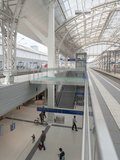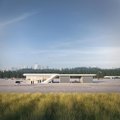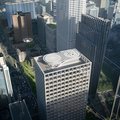New Mobility
|
by NOW, NEAR, NEXT, |


Air Taxi Voloport by GRAFT
@ bloomimages Berlin GmbH


Refurbishment and conversion of the main station in Salzburg by kadawittfeldarchitektur
© Taufik Kenan
Transport of the Future
A modern, digitally-driven mobility culture requires a reorientation in the spatial and infrastructural area. With the help of digital applications, the transport of goods and people can be organised more efficiently and with less strain on resources. Changed information and communication systems enable increased efficiency of private and public transport. The possibilities range from sharing concepts and networking platforms to the use of artificial intelligence. Demand-oriented transport concepts lead to a stronger individualisation of the offer instead of the previous regular operation. The potential of automation or autonomous driving lies in the intelligence of the independently acting systems. The mobility requirements for rural areas differ greatly from those in urban areas.
New mobility structures and buildings, so-called mobility hubs, are part of the mobility and infrastructure of tomorrow, which will enable structural networking as a meeting and hub point. The integration of mobility offers in buildings as well as new infrastructure buildings form a new typology. These places must be redeveloped and redefined in terms of function and design in order to be able to function as a model for mixed-use buildings with overlapping uses. Integration into existing urban structures, traditional modes of transport and existing infrastructures always plays an important role. Mobility planning can only succeed through interdisciplinary exchange.
Combining infrastructure and city life
To integrate the Hauptbahnhof Salzburg station into the city, kadawittfeldarchitektur was not only given the complex task of arranging the railway tracks anew. Above all, the historic station from 1860 with its "authentic" appearance had to be integrated into a master plan that reconnects the city districts on both sides of the tracks through several bridges and passages. Until then, the neighbouring districts Elisabeth-Vorstadt and Schallmoos, situated around the station, were joined only via a small passageway above the tracks. The highly elevated railway tracks and noise-protection walls amplified the barrier effect. The new plans foresaw functional as well as urban elements for integrating the station into the fabric of the city: a central, up to twenty meter wide underpass leading from the historic ‘Jugendstil‘hall to a new train station entrance, creates a new connection from Elisabeth-Vorstadt to Schallmoos. The exchange between three railway bridges, west of the train station and new developments along the tracks, renew a connection between city and rail.
By enlarging the platform underpass and creating a naturally lit shopping arcade, the access route to the tracks is transformed from being a dark passage to a busy pedestrian zone. The reorganisation of Salzburg Central Station with a new entrance on the east side of the station is an urban densification project, which has helped to not only create public space but also connect the city districts on either side of the tracks.
Accessed via the restored historic railway hall, the shopping arcade, which is designed as a landscaped urban space with large open areas, not only connects the various levels and functions of the station project but also activates urban life by functioning as a link between the two city districts either side of the tracks.
When travellers wander through the shopping arcade – starting at the refurbished entrance building from 1860/1909, via the new roof landscape covering the tracks, a synthesis of the finely structured historical halls (1909) and the curved platform roofing (2013), and ending at the new roof sculpture of the eastern entrance (2014) – they also experience the long history of Salzburg Central Station. Even the historic vaults above the platforms are visible from the open-roofed passage that is positioned below the tracks, perpendicular to the platforms and accessible via the historic station hall.
The tracks as well as the platforms are covered mainly in glass, transparent membrane roofs and pneumatic air-cushions. Thus a bright and transparent station hall is created with totally new characteristics.
“The construction work was "open-heart surgery" - the reconstruction of the station took place while the station was still in operation with around 25,000 passengers daily.”
Individual air traffic
The German eVTOL design company Volocopter is a pioneer of Urban Air Mobility and develops fully electric vertical take-off aircraft as a mobility solution for use in urban areas. As a hub for the Volocopter aircraft, the VoloPort vertiport was devised by GRAFT in collaboration with Volocopter, Arup and Bayards Aluminium Constructies.
The VoloPort is part of the Volocopter urban air mobility infrastructure network and acts as a gateway within the public realm. Suited to the constraints of densely populated areas, its compact, modular and expandable design can be employed in a variety of urban locations – either on the ground, on the roof of a high-rise building or on a floating, water-based platform.
The exterior of the VoloPort features dynamic lines in horizontal, vertical, and diagonal planes. By connecting earth and sky, this gesture inspires passengers to anticipate the experience of flight, while the distinctive lighting concept will make it into an easily recognizable landmark atop of skyscrapers, parking garages and floating platforms. Retaining all key design elements across all configurations and sizes, the fully functional, branded unit incorporates all necessary passenger services and aircraft operations, such as battery swapping and charging, elevating platforms for maintenance, and fire detection and rescue. The VoloPort is tailored to act as a hub for the VoloCity and VoloConnect aircraft, and may also accommodate other aircraft.
The design of the VoloPort allows for different configurations, enabling adaptability to regulatory changes.
Each unit can be configurated on a single level or on multiple levels. Multiple level units are arranged into three elements that divide different functions: the plinth, the terminal, and the platform. The plinth is of varying heights and is designed to distribute loads according to the specific location, especially when sited on constrained decks or existing constructions. The terminal is connected to the FATO (Final Approach and Take-Off) platform on the upper deck by a perforated material that allows sufficient air flow to prevent turbulence. Both the terminal units and the platform are made from pre-assembled lightweight modules.
While the VoloPort offers an expandable, network-ready vertiport solution for dense urban areas, it can also be employed next to transport terminals in rural locations.
The VoloPorts for Volocopter are designed to be employable globally. We developed a modular system that is realizable in different locations around the world, taking into account the locally applicable regulations as well as the different climatic and manufacturing conditions – while at the same time making the customer’s corporate identity clearly recognizable. This system is so flexible and robust that it can be implemented in locations as different as Saudi Arabia and Norway.
| Client |
Volocopter GmbH |
| Status |
2021: Commission for VoloPort, GRAFT together with Arup and Bayards Aluminium Constructies 2019: First prototype built in Singapore by GRAFT Brandlab 2018: Competition, 1st prize, together with GRAFT Brandlab and Arup |































